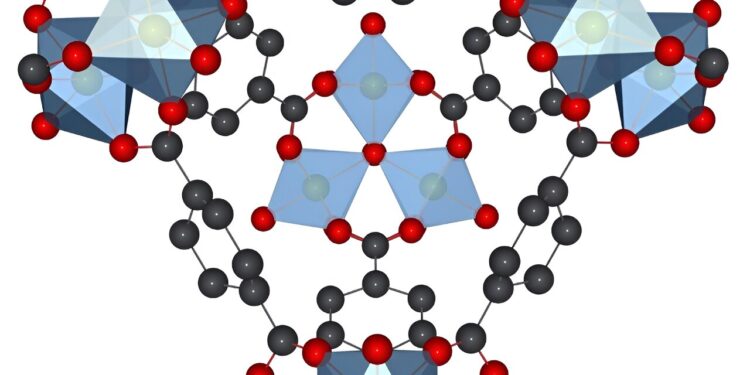Increasing the pore size of this chromium-containing MOF improved its ability to transport and deliver two common drugs: ibuprofen and 5-fluorouracil. Credit: Fateme Rezaei
The spongy structure of metal-organic frameworks (MOFs) allows these polymers to transport and deliver a range of therapeutic compounds. Today, researchers report in ACS Applied Biomaterials treated a chromium-containing MOF with a dose of acetic acid, more concentrated than in vinegar, to increase its pore size and surface area. The inflated MOF contained more ibuprofen or chemotherapy drug than the original version and showed improved performance as a potential drug delivery vehicle.
Taking medications orally is a convenient way to administer pharmaceuticals. However, this method sometimes involves ingesting several tablets per day, or requires large tablets that may be difficult to swallow. Thus, researchers are investigating how to use MOFs for drug delivery to minimize the frequency of administration and maximize treatment effectiveness. By customizing the pore size and structure of polymers, scientists have created nanoscale vehicles that can provide more controlled and targeted drug release.
However, to transport and deliver even more drug molecules, the pores would need to expand further than current versions can. A research team led by Fateme Rezaei of the University of Miami wanted to optimize an existing MOF and improve the polymer’s delivery of two common therapeutics of different molecular sizes: ibuprofen, an anti-inflammatory, and a compound more small, 5-fluorouracil, a chemotherapy drug used. to treat cancer.
They started with an established method for synthesizing a biocompatible chromium-containing MOF and added a step with an acetic acid rinse. The acid caused the pores of the polymer to expand from about 2.5 nanometers (nm) to 5 nm wide. In laboratory experiments to characterize the drug-loading capacity of the MOF, researchers observed that the inflated version absorbed more ibuprofen and 5-fluorouracil molecules than the chromium-containing structure with sized pores. standard.
Then, in drug delivery experiments, they loaded the enlarged-pore and standard MOFs with ibuprofen or 5-flurouracil and measured how quickly the drugs passed through saline. Rezaei and his colleagues found that the new frames released both drugs much more quickly than the originals. The researchers attributed the higher rates of drug loading and release to the larger pores and surface area of the expanded framework, which provide larger “gates” for drug molecules to enter and exit.
Simple changes like these could maximize the effectiveness of MOFs in future drug delivery applications, the researchers say. As a next step, they plan to determine how slow, gradual release of the drug within specified time frames can be achieved by modifying the pore structure of the MOF.
More information:
Neila Pederneira et al, Performance of MIL-101(Cr) and MIL-101(Cr)-Pore Expanded as Drug Carriers for Ibuprofen and 5-Fluorouracile Delivery, ACS Applied Biomaterials (2024). DOI: 10.1021/acsabm.3c01007
Provided by the American Chemical Society
Quote: Researchers develop inflated MOFs to improve drug delivery (January 26, 2024) retrieved January 27, 2024 from
This document is subject to copyright. Apart from fair use for private study or research purposes, no part may be reproduced without written permission. The content is provided for information only.



